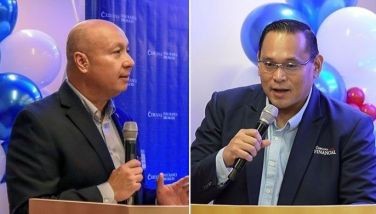Smart schools program comes full circle
May 8, 2006 | 12:00am
"From relying mainly on books for their lessons due to lack of additional resources, almost all of our teachers are now comfortable in using the computer and surfing the Internet," vows Rosa Centeno, principal of Malabon National High School.
In just over two years since it first provided two public high schools in Malabon City and Cebu with Internet connection and the know-how through supplementary training, the Smart Schools Program (SSP) is continuing to plant seeds of IT excellence in various public high schools nationwide.
With efforts in full swing, SSP, a flagship community service initiative of Smart Communications, Inc. (Smart) in aid of secondary education, is making sure that come opening of classes this June, more students and teachers will be trooping to schools better attuned to the use of Internet and computer technology as educational tools.
Working round the clock to reach as many public schools in even the most remote areas, Smart had, for the past three months, recently turned over a number of teacher learning resource facilities to different SSP partner schools from as far as Lamitan, Basilan and Bontoc, Mountain Province.
Smart Schools facilities were inaugurated in these schools: Signal Village High School, Olongapo City National High School, Ayala National High School – Zamboanga del Norte, Basilan National High School, Lamitan National High School, Mt. Province General Comprehensive High School, Minglanilla National Science High School, Tabaco National High School, West Visayas State University – Integrated Laboratory School, and Ramon Avanceña National High School in Iloilo City.
Joining the list of adopted Smart Schools Program partners are: Urdaneta National High School, Sagada National High School, Nueva Vizcaya General Comprehensive National High School, Cavite National High School, Cabantian National High School, Zamboanga City National High School-Main, and Nueva Ecija National High School.
These public high schools have different profiles. Some are national high schools, a number are general comprehensive high schools, science high schools, and vocational and trade schools. One thing they have in common is their performance as centers of excellence in their areas.
A 2005 National Awardee for the Best Cultural Education Lesson Exemplar (CELEX) Pilot School, the Tabaco National High School, like other SSP partner schools, appreciates the new opportunity presented by the program. According to its principal Virgilio T. Navarro, "Being a recipient of the Smart Schools Program will definitely enhance the capabilities of our school to connect to the outside world and will give our teachers and students access to global information."
The Smart Schools Program learning centers serve as the gateway connecting the schools to the World Wide Web. Using the PLDT Group’s wide range of connectivity solutions, each center has been equipped with networked computers and peripherals connected to the Internet which is given for free by Smart for a period of one year.
"Now, access to the outside world is only at our finger tips. We can stay informed about the latest in terms of news and strategies, and even on the practices being adopted by schools in other parts of the world," notes Evelyn Joyce N. Taguiba, principal of Mountain Province General Comprehensive High School, who takes pleasure in seeing the realization of a dream to "have a school up in the mountains that is comparable to schools in the city."
This summer break, Smart undertakes to strengthen the human factor of the program by training more teachers and non-teaching personnel from various partner schools. To date, over 1,439 public high school teachers have been trained on basic Microsoft Office skills. Twelve have also been trained on basic laboratory technical troubleshooting. Soon, they will also receive advance training on Visual Basic.Net (VB.net) and computer networking. At the end of the day, SSP challenges these educators to apply their acquired knowledge and skills to ultimately benefit their students.
Trainings are conducted in partnership with Microsoft’s Partners in Learning Program (PIL) and the schools partners under the Smart Wireless Engineering Education Program (SWEEP), Smart’s industry-academe program for colleges and universities that aims to improve engineering education in the country.
With Internet access and the necessary training, educators from SSP partner schools have been given yet another tool to make sure they make the most out of the Internet as a learning resource – the Smart Schools website (www.smartschools.ph).
Launched recently, the site offers access to online content that teachers can use for research, in making class presentations and in exchanging best practices with colleagues. Among its sections is the "Smart Tools" which contain tips on using Internet technologies such as email, chat, and search engines, as well as, downloadable modules and a listing of around 100 recommended educational sites.
"I am able to use online references to acquire data that I can add to my class discussions," shares Victoriana Bondoc, ICT coordinator and science department head of Francisco G. Nepomuceno Memorial High School in Angeles, who surfs the Internet for useful information two or three hours a day.
The website is also a means by which various SSP schools all over the country can stay connected. It is also the foundation on which will be built an online community of educators and learners who can help shape the future of education in the country.
Moreover, the website completes the three components of SSP which is internet access, access to online content and various hosting solutions, and training for teachers and stakeholders or ACT.
With its key components soundly in place, SSP has come full circle in its quest to utilize technology in our advancement as a nation by improving the educational system, empowering the teachers with information and ultimately benefiting the students.
Smart Schools Program is being implemented through the Philippine Business for Social Progress, with the support of the Department of Education and Microsoft’s Partners in Learning Program.
In just over two years since it first provided two public high schools in Malabon City and Cebu with Internet connection and the know-how through supplementary training, the Smart Schools Program (SSP) is continuing to plant seeds of IT excellence in various public high schools nationwide.
With efforts in full swing, SSP, a flagship community service initiative of Smart Communications, Inc. (Smart) in aid of secondary education, is making sure that come opening of classes this June, more students and teachers will be trooping to schools better attuned to the use of Internet and computer technology as educational tools.
Working round the clock to reach as many public schools in even the most remote areas, Smart had, for the past three months, recently turned over a number of teacher learning resource facilities to different SSP partner schools from as far as Lamitan, Basilan and Bontoc, Mountain Province.
Smart Schools facilities were inaugurated in these schools: Signal Village High School, Olongapo City National High School, Ayala National High School – Zamboanga del Norte, Basilan National High School, Lamitan National High School, Mt. Province General Comprehensive High School, Minglanilla National Science High School, Tabaco National High School, West Visayas State University – Integrated Laboratory School, and Ramon Avanceña National High School in Iloilo City.
Joining the list of adopted Smart Schools Program partners are: Urdaneta National High School, Sagada National High School, Nueva Vizcaya General Comprehensive National High School, Cavite National High School, Cabantian National High School, Zamboanga City National High School-Main, and Nueva Ecija National High School.
These public high schools have different profiles. Some are national high schools, a number are general comprehensive high schools, science high schools, and vocational and trade schools. One thing they have in common is their performance as centers of excellence in their areas.
A 2005 National Awardee for the Best Cultural Education Lesson Exemplar (CELEX) Pilot School, the Tabaco National High School, like other SSP partner schools, appreciates the new opportunity presented by the program. According to its principal Virgilio T. Navarro, "Being a recipient of the Smart Schools Program will definitely enhance the capabilities of our school to connect to the outside world and will give our teachers and students access to global information."
The Smart Schools Program learning centers serve as the gateway connecting the schools to the World Wide Web. Using the PLDT Group’s wide range of connectivity solutions, each center has been equipped with networked computers and peripherals connected to the Internet which is given for free by Smart for a period of one year.
"Now, access to the outside world is only at our finger tips. We can stay informed about the latest in terms of news and strategies, and even on the practices being adopted by schools in other parts of the world," notes Evelyn Joyce N. Taguiba, principal of Mountain Province General Comprehensive High School, who takes pleasure in seeing the realization of a dream to "have a school up in the mountains that is comparable to schools in the city."
This summer break, Smart undertakes to strengthen the human factor of the program by training more teachers and non-teaching personnel from various partner schools. To date, over 1,439 public high school teachers have been trained on basic Microsoft Office skills. Twelve have also been trained on basic laboratory technical troubleshooting. Soon, they will also receive advance training on Visual Basic.Net (VB.net) and computer networking. At the end of the day, SSP challenges these educators to apply their acquired knowledge and skills to ultimately benefit their students.
Trainings are conducted in partnership with Microsoft’s Partners in Learning Program (PIL) and the schools partners under the Smart Wireless Engineering Education Program (SWEEP), Smart’s industry-academe program for colleges and universities that aims to improve engineering education in the country.
With Internet access and the necessary training, educators from SSP partner schools have been given yet another tool to make sure they make the most out of the Internet as a learning resource – the Smart Schools website (www.smartschools.ph).
Launched recently, the site offers access to online content that teachers can use for research, in making class presentations and in exchanging best practices with colleagues. Among its sections is the "Smart Tools" which contain tips on using Internet technologies such as email, chat, and search engines, as well as, downloadable modules and a listing of around 100 recommended educational sites.
"I am able to use online references to acquire data that I can add to my class discussions," shares Victoriana Bondoc, ICT coordinator and science department head of Francisco G. Nepomuceno Memorial High School in Angeles, who surfs the Internet for useful information two or three hours a day.
The website is also a means by which various SSP schools all over the country can stay connected. It is also the foundation on which will be built an online community of educators and learners who can help shape the future of education in the country.
Moreover, the website completes the three components of SSP which is internet access, access to online content and various hosting solutions, and training for teachers and stakeholders or ACT.
With its key components soundly in place, SSP has come full circle in its quest to utilize technology in our advancement as a nation by improving the educational system, empowering the teachers with information and ultimately benefiting the students.
Smart Schools Program is being implemented through the Philippine Business for Social Progress, with the support of the Department of Education and Microsoft’s Partners in Learning Program.
BrandSpace Articles
<
>
- Latest
Latest
Latest
November 29, 2024 - 9:30am
November 29, 2024 - 9:30am
November 28, 2024 - 8:00am
November 28, 2024 - 8:00am
November 25, 2024 - 1:00pm
November 25, 2024 - 1:00pm
November 19, 2024 - 12:00am
November 19, 2024 - 12:00am
November 18, 2024 - 9:32am
November 18, 2024 - 9:32am
Recommended






























